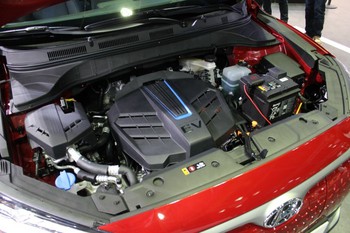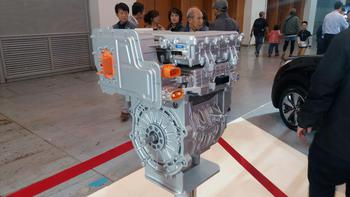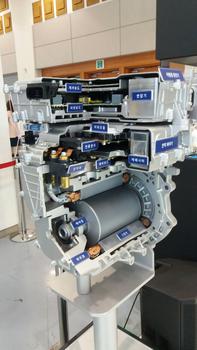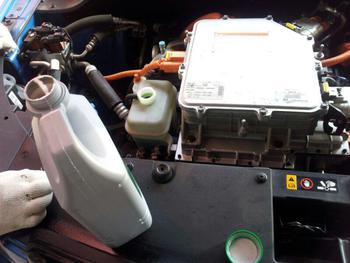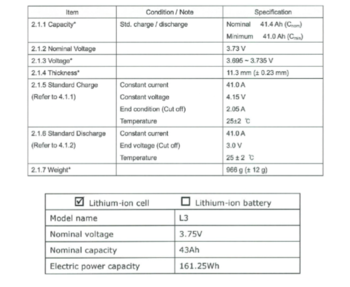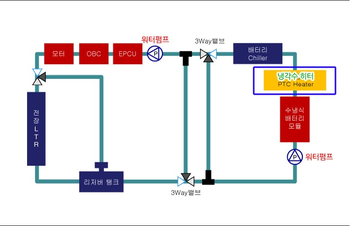-
Am posting this in the Ioniq EV forum because Hyundai has stated they will be using the same modular components in all their new electric vehicles.
The first two EVs to show this new architecture are the Kona EV and the Niro EV, but next year I expect to see both an updated Ioniq EV and a new Soul EV based on this.
This first post will show the new battery layout, in the next post I will show the new OBC and motor components.
--------------------------------------------------
Here are some photos of the Kona EV I took at EVTrend Motor Show in Seoul in April. Plus a couple I found on the web.
The cutaway model on display is of the 64kWh version.
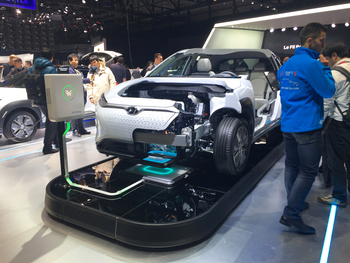
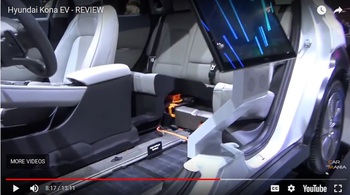


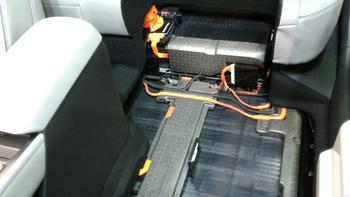
I counted the cells! There are 288. The cells are laid out 3 in parallel to form a 3 cell group, 96 groups in series.
Under the floor are 6 modules of 10 cell groups, under the back seat are 4 modules of 9 cell groups.
(6*10*3) + (4*9*3) = 288
The nominal voltage of each cell is 3.7V, the rated capacity of each cell is 60Ah
Thus the nominal capacity of the 64 version is 3.7*60*288 = 63.94kWh
I didn't see a 39.2kWh Kona EV on display. But I did see an image of its battery pack.
The 4 modules under the seat are empty.
Under the floor are 6 modules of 15 cell groups. But for this version the cells are laid out 2 in parallel to form cell pairs.
Hence this version has 180 cells.
For the math to work out the nominal voltage of each cell has to be 3.63V
I don't know why it is lower than the 3.7V of the 64kWh version.
3.63*60*180 =39.24kWh
The official specs are here - https://www.hyundai.com/kr/ko/vehicles/kona-electric/specifications
327 / 90 = 3.63V : 60Ah*2 = 120Ah
--------------------------------------------------
The Niro EV went on show at the 5th Jeju EV Expo -

I don't have any internal details on the battery pack other than the capacity is identical, but also externally it is identical to the Kona EV.
Both are the same size and shape, and have ridging showing the module layout.

Both have a cover under the front passenger seat to access the Power Relay Assembly

-
Am posting this in the Ioniq EV forum because Hyundai has stated they will be using the same modular components in all their new electric vehicles.
The first two EVs to show this new architecture are the Kona EV and the Niro EV, but next year I expect to see both an updated Ioniq EV and a new Soul EV based on this.
This first post will show the new battery layout, in the next post I will show the new OBC and motor components.
--------------------------------------------------
Here are some photos of the Kona EV I took at EVTrend Motor Show in Seoul in April. Plus a couple I found on the web.
The cutaway model on display is of the 64kWh version.





I counted the cells! There are 288. The cells are laid out 3 in parallel to form a 3 cell group, 96 groups in series.
Under the floor are 6 modules of 10 cell groups, under the back seat are 4 modules of 9 cell groups.
(6*10*3) + (4*9*3) = 288
The nominal voltage of each cell is 3.7V, the rated capacity of each cell is 60Ah
Thus the nominal capacity of the 64 version is 3.7*60*288 = 63.94kWh
I didn't see a 39.2kWh Kona EV on display. But I did see an image of its battery pack.
The 4 modules under the seat are empty.
Under the floor are 6 modules of 15 cell groups. But for this version the cells are laid out 2 in parallel to form cell pairs.
Hence this version has 180 cells.
For the math to work out the nominal voltage of each cell has to be 3.63V
I don't know why it is lower than the 3.7V of the 64kWh version.
3.63*60*180 =39.24kWh
The official specs are here - https://www.hyundai.com/kr/ko/vehicles/kona-electric/specifications
356V / 96 = 3.7V : 60Ah*3 = 180Ah
327 / 90 = 3.63V : 60Ah*2 = 120Ah
--------------------------------------------------
The Niro EV went on show at the 5th Jeju EV Expo -

I don't have any internal details on the battery pack other than the capacity is identical, but also externally it is identical to the Kona EV.
Both are the same size and shape, and have ridging showing the module layout.

Both have a cover under the front passenger seat to access the Power Relay Assembly

-



